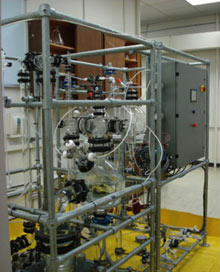| A Yale spinoff hopes
to solve the big problem with desalination.
Access to clean water is severely limited in
many parts of the world, and while desalination plants can separate freshwater
from sea and brackish water, they typically require large amounts of electricity
or heat to do so. This has prevented desalination from being economically
viable in many poorer cities and countries.
|
The company is using what it calls engineered
osmosis. Unlike conventional desalination systems, the Oasys system establishes
an osmotic pressure gradient instead of using pressure or heat to force
water through a purifying membrane. The approach exploits the fact that
water naturally flows from a dilute region to one that's more concentrated
when the two solutions are separated by a semipermeable material, thereby
saving the energy normally needed to drive the process.
In Oasys's system, a "draw solution" is added on one side of the membrane to extract clean water from dirty water. The solution used by Oasys is designed to have a high osmotic pressure and be easy to remove through heating. "Forward osmosis is not a new technology, but trying to find the optimal draw solution to make it efficient and create the proper balance of ammonia and chlorine is critical," says Michael LoCascio, senior analyst with Lux Research. The biggest challenge, according to Mandell, was identifying a concentrated solution that could be removed efficiently and entirely. Details of Oasys's draw solution are a company secret, but it uses ammonia and carbon-dioxide gases dissolved in water in specific proportions. Crucially, the solution can be reused after being removed from clean water, and the membrane required is also nearly identical to those already used in reverse osmosis. While other companies are doing forward osmosis, Oasys claims that its draw solution makes its technology much more efficient. Reverse osmosis currently produces water at a cost of about $0.68 to $0.90 per cubic meter. Oasys estimates that engineered osmosis will cost just $0.37 to $0.44 per cubic meter once fully scaled up. The startup has so far established a pilot-scale plant to test the technology by producing one cubic meter of water per day. Mandell says that it is raising venture financing that will be put toward scaling to around 1,000 to 10,000 cubic meters of water per day. However, this is still well below the scale of many commercial desalination plants. Oasys says that the first market it will focus on will be wastewater reuse. The second will be reprocessing wastewater produced by the oil and gas industries. Instead of having to pay to haul this water away, companies would treat it on-site using the Oasys system. Pour en savoir plus: http://www.oasyswater.com/ |
